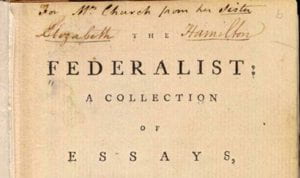By: Keval Bollavaram
Act I of Hamilton summarizes Hamilton’s life and relationship with his peers. Additionally, Act I establishes the role that each character played before and during the Revolution with the key distinction being between Hamilton and Burr. Lin-Manuel Miranda effectively uses repetition throughout the first act to emphasis characteristic attributes and make comparisons between individuals. For example, in the song “Alexander Hamilton” the phrase “by being” is repeated to demonstrate the early accomplishments of Hamilton as well as his impressive character. Furthermore, in the song “Wait for It” Lin-Manuel repeats specific phrases to show the differences in the thought process of Hamilton versus Aaron Burr. When describing Burr, Lin-Manuel repeats the phrases “Wait for it,” but he uses the phrase “climb” to describe how Hamilton takes risks while Aaron Burr demands certainty.
While many songs in Act I include repetition, Lin-Manuel utilizes other literary devices to shift the audience’s attention and misdirect the audience. For example, “Guns and Ships” starts by describing a “secret weapon,” which is “an immigrant you [the audience] know and love.” In the minds of the audience, this hero is Hamilton; however, it turns out the hero is Lafayette, a French officer who would help forge an alliance between the U.S. and France. Additionally, Lin-Manuel uses contradiction in the song “Ten Duel Commandments” when Burr asks Hamilton, “can we agree that duels are dumb and immature?” This phrase is a harbinger for the Hamilton’s own demise during his duel with Burr.

Beyond including highly symbolic sequences, Lin-Manuel infuses historical references to build the plot of the musical. In the song “Guns and Ships,” the characters discuss bringing France into the war in order to end the war in Yorktown. Moreover, George Washington finally gives Hamilton a chance to command troops in Yorktown. The distinctions between Hamilton and Burr are emphasized at the end of the first act. In “Non-Stop,” Hamilton attempts to convince Burr to help write the Federalist Papers in order to defend the creation of the U.S. Constitution. Because Burr is uncertain, Hamilton along with James Madison and John Jay write the Federalist Papers without Burr. These documents are still used today to understand how the founders interpreted the Constitution.
The first act explains Hamilton’s rise to power and his influence while planting the seeds for future conflicts. At the end of the act, there is tension between Hamilton and Burr, the former becomes Treasury Secretary while the latter is still waiting for his chance.